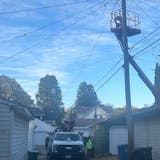Bart Bartholomew, nursery manager at Pahl's Market in Apple Valley, used to wince when people looking for shrubs would tell him what they wanted: a carefree plant that grew no more than 3 feet high and flowered all summer long. Oh, and it would be good if it never needed pruning.
"How about a plastic plant?" he'd think.
Today, he's got more and better options to suggest. Dwarf shrubs and columnar trees are two of the hottest trends in horticulture, and plant breeders have responded to demand by developing smaller plants that cater to busy homeowners with tight spaces.
"One of the traits we're looking for is compactness," said Ryan McEnaney, public relations specialist for Bailey Nurseries, a major plant breeder and producer based in Newport. "People are living in more urban landscapes and condos or apartments, and still want greenery. ... Those who have a more traditional home and who are working on their foundation plantings don't want things that grow over windows."
Intimidation also plays a part in the desire for smaller plants, he added. People who are new to gardening and taking care of their yard are often afraid of killing plants, and pruning can seem scary. "Having something compact is going to take that pruning away."
At Pahl's, one popular dwarf is Bobo, a panicle hydrangea with large white flowers that turn faintly pink in fall. Bobo tops out at about 3 feet tall, and flowers for much of the growing season.
"The growers can't keep up with the demand for them," Bartholomew said.
Hydrangeas in general are hot, with plant breeders turning out more Minnesota-hardy plants with blooms that turn pink or have unusual flower forms. But hydrangeas can be rangy plants that can grow more than 8 feet tall. Bartholomew said customers have been drawn to the smaller Little Quick Fire, which reaches 3 to 5 feet high and has flowers that start out white and turn pink, and Baby Lace, a 4-foot hydrangea with white flowers.


